Coustic D-block User Manual




















INTRODUCTION
Welcome to Coustic’s world of power and clarity. The new Coustic D-block amplifiers deliver the cleanest music you’ve ever heard at any power level in the 12-volt environment. Besides the sleek contoured design, these amplifiers have all the latest and most sophisticated audio features. This manual offers you a guided tour of all these exciting features. For the best sonic reproduction, please follow the installation suggestions and recommendations as closely as possible. The time you spend will prove to be worthwhile when you sit back and enjoy the high fidelity music!
To further explore the potential of your Coustic amplifier, we recommend you match it with our dynamic full-range speakers or subwoofers and electronic crossovers.
Whatever you need for your ultimate car audio system, look to Coustic for a wide range of car audio components to meet the most critical demands.
That’s because . . . Coustic is Performance Tuned!
Please take a moment to register your purchase online at coustic.com.
Please also record the serial number of your amplifier in the space provided below and keep this manual for future reference, as well as your sales receipt as proof of ownership. (The serial number of your amplifier is marked on the bottom of its metal chassis.)
Serial Number:
Date of Purchase:

FEATURES
•Patented, state-of-the-art power supply
•Patent-pending, D-Block Class D technology for high efficiency and interference-free operation
•High mass extruded aluminum heatsink for maximum thermal management and bulletproof reliability
•Adjustable LP Crossover - Variable from 40Hz-200Hz for maximum system design flexibility
•Fully adjustable Bass Boost - 40Hz, 0-18dB to enhance the low frequency experience in your vehicle
•Remote Subwoofer Level Control included allows you to fine tune the bass from the driver’s position
•Defeatable Subsonic Filter at 30 Hz for improved efficiency and sonic performance
•High Level Input with patented Intelli-Sense™ auto turn-on for easy installation with factory radios
•CEA 2006 Compliant. All power ratings are not created equal. CEA 2006 Compliance ensures
that the power of this amplifier is measured according to strict standards dictated by the Consumer Electronics Association.
SPECIFICATIONS
|
AMP600DB |
AMP800DB |
AMP1200DB |
AMP1600DB |
|
|
|
|
|
|
|
RMS per channel @ |
150 Watts |
200 Watts |
300 Watts |
400 Watts |
|
4Ω(≤1% THD+N) |
|||||
|
|
|
|
||
|
|
|
|
|
|
RMS per channel @ |
300 Watts |
400 Watts |
600 Watts |
800 Watts |
|
2Ω(≤1% THD+N) |
|||||
|
|
|
|
||
|
|
|
|
|
|
Signal to Noise Ratio |
75 dBA |
75 dBA |
75 dBA |
75 dBA |
|
|
|
|
|
|
|
Frequency Response |
20Hz to 200Hz (-3dB) |
20Hz to 200Hz (-3dB) |
20Hz to 200Hz (-3dB) |
20Hz to 200Hz (-3dB) |
|
|
|
|
|
|
|
Maximum Input Signal |
5V |
5V |
5V |
5V |
|
|
|
|
|
|
|
Maximum Sensitivity |
100mV |
100mV |
100mV |
100mV |
|
|
|
|
|
|
|
THD+N |
<0.25% (reference:1W |
<0.25% (reference:1W |
<0.25% (reference:1W |
<0.25% (reference:1W |
|
(Distortion) |
output) |
output) |
output) |
output) |
|
|
|
|
|
|
2
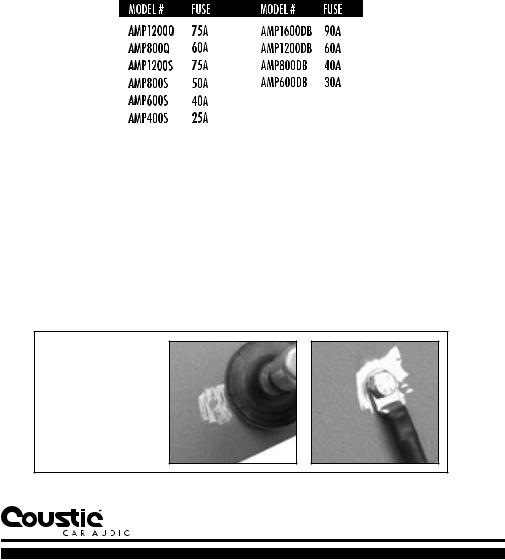
INSTALLATION
 Disconnect the ground at the vehicle battery before proceeding.
Disconnect the ground at the vehicle battery before proceeding.
1. Connect the amplifier to the battery
For maximum amplifier performance, we suggest 4 gauge wire and a 1 Farad stiffening capacitor. A fuse or circuit breaker is required at maximum distance of 18” from the battery to protect the battery, the vehicle, and more importantly you (see chart below for proper fuse ratings). It is highly
recommended that installation be carried out by an authorized dealer.
2. Connect the amplifier remote turn-on
Connect the remote input terminal of the amplifier to the remote output terminal of the source unit (only if using RCA inputs) to establish amplifier remote on/off through the power on/off of the source unit. If the source unit does not provide a remote output, connect to a switched 12-volt source, e.g. ignition switch.
3. Connect the amplifier ground to the vehicle chassis
For maximum amplifier performance we suggest 4 gauge wire. Find a solid piece of metal and scrape the paint away where the ground will be attached (NO FACTORY BOLTS). Connect the ground cable to the amplifier at this point.
- NOTE -
For optimum performance and sound reproduction, prepare and secure the ground properly. Remove any surface material before securing to your chassis, ensuring a metal-to-metal ground point.
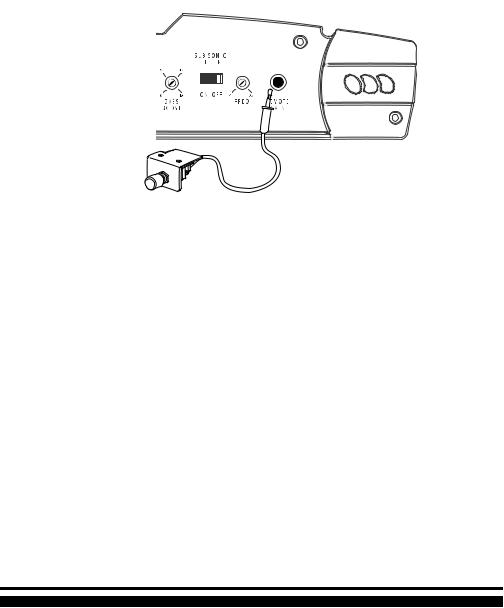
4. Remote Gain Control
Included is a remote gain control, which is a volume control that is active with the low pass filter engaged. This control should be mounted near the driver in an easily accessed location. This is not a gain knob, this is a level control. The level control will attenuate the amp or increase its output to the level of the gain setting. It is used to adjust bass output between music sources or tracks (see picture below for connection location).
5. Connecting signal cables to the amplifier
There are two ways to supply the signal to our amplifiers. To get maximum performance, we suggest connecting a high quality RCA to the corresponding outputs at the source unit and inputs of the amplifier. If a source unit is being used without RCA outputs, use the high-level inputs for signal which will turn the amplifier on via our Intelli-Sense™ circuitry (Four-channel amps will only engage on the front high-level inputs).
6. Reconnect the battery ground to the vehicle battery
Double check all the previous installation steps. Make certain the wiring and component connections are securely attached to the amp +BATT, remote and ground. If everything is in order, complete the installation by reconnecting the battery ground to the vehicle battery.
4
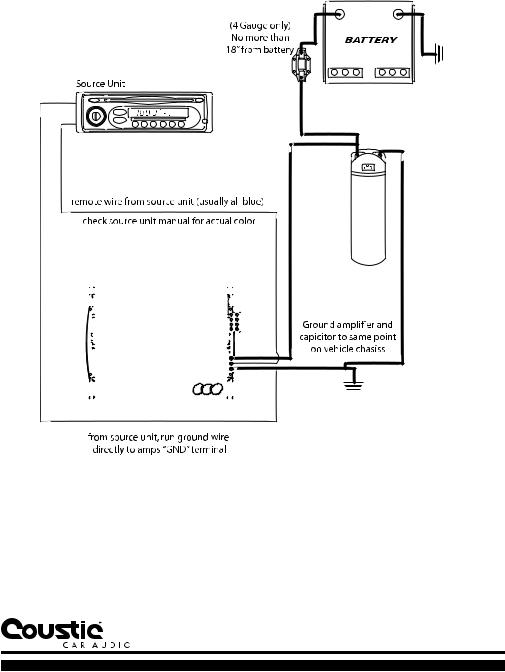
WIRING DIAGRAM (CHARGING SYSTEM)
1 Farad Stiffening Capacitor

WIRING DIAGRAM (5.1 SURROUND SOUND EXAMPLE)
6
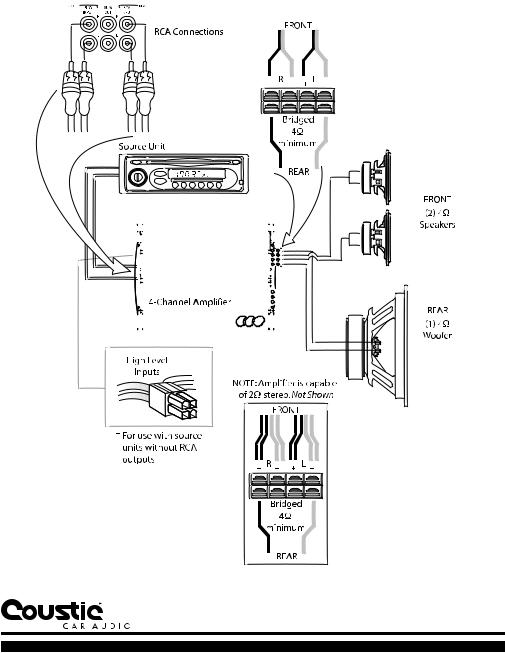
WIRING DIAGRAM (SINGLE 4-CHANNEL AMPLIFIER SYSTEM)
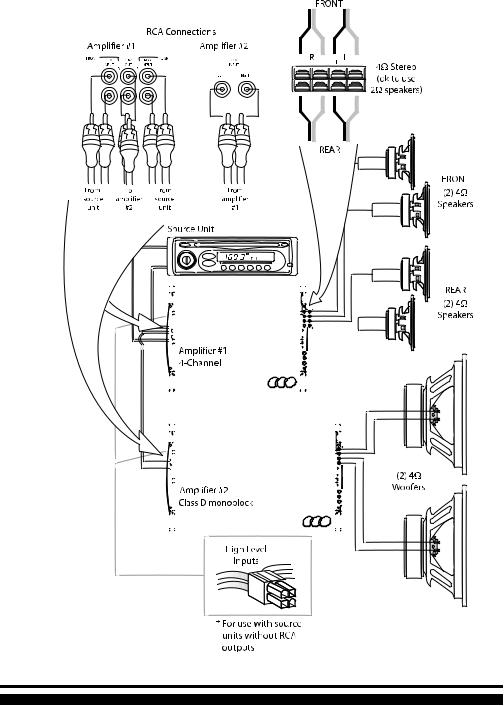
WIRING DIAGRAM (MULTI AMPLIFIER SYSTEM)
8

SYSTEM TUNING (INPUT GAIN ADJUSTMENT)
Located on the Input Panel, the objective of GAIN adjustment is to match the output of the source unit with the input of the amplifier. The output voltage of individual source units can vary. Some source units have an output of 200 mV and others have 5 Volts or more. To cater to these variations, the amplifier has an adjustable gain control that ranges from 100 mV to 5 volts. Adjusting this control requires some experimenting to ensure all of the gain is at the beginning of the system, NOT at the end (amplifier). Turn your source unit up and keep your amplifier gains at the lowest possible setting (counter-clockwise) with the maximum output. This will give you the best sound and signal-to-noise ratio.
Besides better sonic reproduction, proper input gain also helps to prolong the reliability span of your amplifier by eliminating excessive internal temperature generated by incompatible source unit output and amplifier input.
Note : Turning the input gain up does not indicate more power. Just more noise. The input gain control is not a power control.
If the Remote Gain is used, connect the plug of the Remote Gain to the port on the panel of the amplifier.
1.Turn the input GAIN all the way down (counter clockwise).
2.Set the volume control of the source unit to approximately 3/4 of its maximum output.
3.Turn the balance control of the source unit to its center position (flat).
4.Leave the tone (bass/treble) controls at their usual position (flat).
5.Play a CD or tape track with great dynamic range.
6.Use the Bass Boost Control on the amp to enhance the bass performance (if desired), not the bass on the headunit. Use this control sparingly.
7.To locate the optimum gain setting, ask the person assisting you to turn the input GAIN control clockwise until audio distortion starts to develop. Turn the gain control backwards slightly to minimize the distortion.
8.If you constantly switch between CD/tape and radio, you will need further adjustment since radio output level differs from that of CD or tape. In this case, you need to locate a balanced gain setting which is best for both the output level of radio and that of CD or tape
